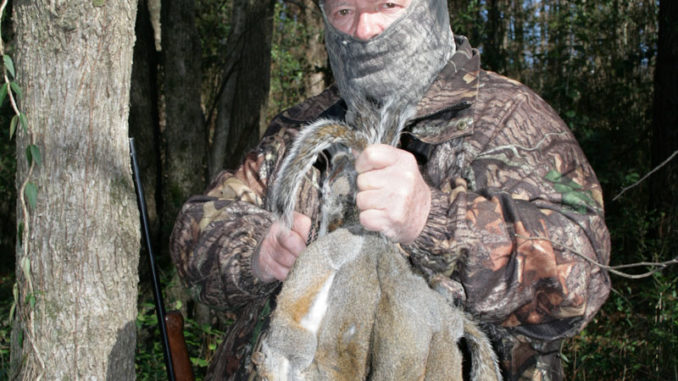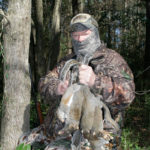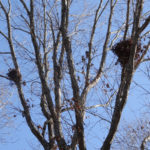
Good habitat can equal great squirrel hunting.
Squirrel hunting is more than just an after-deer or offseason chance to be in the woods. For many hunters, January is the prime month to hunt one of their favored game species. Many hunters actually cut their hunting teeth on squirrels and learned the ways of the woods, honing woodsmanship skills pursuing this often underestimated game species.
Such was the case for Chuck Porter of Sumter, but he was more than 60 years old before he tried squirrel hunting. Once hooked on hunting bushytails, he became obsessive about hunting his newfound quarry. Accompanying Porter on a squirrel hunt seems like a high-tech Delta Force stalk right out of a Chuck Norris movie.
Porter takes the sport seriously but has a ton of fun doing so.
“I have hunted deer and other game species for years, but (I) never really experienced the joys of hunting squirrels until a few years ago,” Porter said. “There are a lot of things to love about squirrels and squirrel hunting. I hunt them when the season opens in October, but because a lot of private hunting places limit squirrel or small-game hunting because of deer season, I usually do most of my hunting from January though the end of the season. When deer season ends, I get access to a lot of land once deer hunters are gone.”
Porter said one reason squirrels are a favored target is the diversity of ways they can be hunted.
“Once the leaves are off the trees, squirrels are found in the trees, but also a lot of time on the ground,” he said. “I look for the presence of a lot of squirrel nests and den trees as good indicators of a lot of squirrels. Also, they move a lot in cold weather, which makes hunting very interesting and sometimes even fast-paced.
“They are looking for food, so that is my first requirement when selecting a spot. I look for areas where they have food sources. What I’ve found to be very true is that if you get there early and set up quietly, it won’t take long to see if they are in the woods with you. I get there before light, sit still, and shortly after daylight, the woods will either be teeming with squirrels or there will be few or none. If there are none visible very soon after daylight, I look for another area and a happier hunting ground. I may check the place again in a few weeks to see if conditions have changed and squirrels are present. There is movement during the winter by squirrels, and places can be hot for hunting, then get cold — and vice versa.”
Porter said to not underestimate squirrels as easy prey for a hunter — a 10-squirrel daily limit can be a real task.
“I hunt in full camo gear, as much as any turkey hunter would use, when on private lands,” he said. “They are sensitive to movement and noise, and I use every resource to stack the odds in my favor.”
Billy Dukes, the assistant chief of wildlife for the S.C. Department of Natural Resources, was formerly the agency’s small-game biologist; he had expertise in the Palmetto State’s squirrel populations.
“On a statewide basis, we are literally covered up in gray squirrels,” Dukes said. “We don’t do squirrel counts, but it’s safe to say we have millions of them in South Carolina. They are one of the few species that may actually under-utilized by hunters. There is great hunting on private lands as well as WMAs. On the WMAs, hunters need to check specific regulations because of certain restrictions or species emphasis, especially on smaller areas. For example, some WMAs focus on waterfowl, so the habitat might not be right.”
Dukes also said squirrels are the ideal game animal to begin someone’s hunting career.
“I love to see adults take youngsters squirrel hunting,” he said. “There’s usually plenty of activity, which keeps their interest high, plus they usually are able to harvest some game and have their hunting instincts developed.
“Despite their numbers, squirrel hunting is not easy, and to be successful consistently means hunters of all ages will develop woodsmanship skills that can be important for other species — as well such as accurate shooting skills, patience and observation.”
Dukes said squirrel populations are all dependent on habitat, which includes available food at a given time.
“Generically, squirrels will be found in the highest numbers in major river drainages, especially in hardwood bottoms, swamps and areas where there is a variety of food sources,” Dukes said. “Squirrels will move from one area to another for food and can do so in large numbers.”
Porter said because there are so many squirrels, hunting them may seem easy, but harvesting them is not necessarily simple.
“It does require good woodmsanship, patience and a good shooting eye, all qualities that can be developed as you hunt,” said Porter, who uses two primary methods: stalking and stand hunting. Plus, he will use a .22 rifle in some instances or a shotgun in others.
“The weapon of choice will depend on the habitat I’m hunting,” he said. “Sometimes, the terrain in a swamp or bottom will thick and gnarly, and a lot of the shooting will be close quarters and on moving squirrels. For me, a shotgun works best in those places.
“However, my favorite areas — the type I really enjoy most — are the open bottoms where there are tall trees and plenty of visibility from January through the end of the season. This is where I love to use a .22 rifle. I use a scope, have it sighted in well and often use a tree as a brace to steady the gun. But bagging a limit of squirrels with a rifle is no easy task. I try to wait on a moment when the squirrel stops when shooting a .22.”
Porter also said terrain, or sometimes his mood, will dictate whether he stalks or sits in one position.
“I really enjoy stalking though the woods, slipping from one piece of cover, such as a big tree, to another,” he said. “It’s crucial to move very slowly and smoothly — no sudden snap movements. Once I advance a few steps, I wait for a while for a squirrel, or sometimes several squirrels, to begin moving. Often I can take one or two quickly, then if I wait just a few minutes, the others will begin to move again.
“I’ve also learned that sometimes I can slip into an area that’s not very large and hunt slow going in and be just as effective by hunting my way back out. Squirrels move a lot during the course of a mid-winter day, something a lot of hunters don’t realize. Certainly, the most activity is early and late, and those are my prime hunting times, but I can literally hunt effectively all day.
“In a large area, I’ll hunt a path that covers the entire area with good habitat as much as possible in a zig-zag loop. By the time I get back to my vehicle, I have hunted the entire area effectively. On small areas I’ll hunt in and then I’ll hunt back out. Taking squirrels moving back though an area where I was hunting an hour or two earlier, even when there were none before, is common. To take a limit of squirrels while stalking requires all types of woodsmanship skills, but none more important than patience and observation. Sometimes a single flick of a squirrel’s tail will be all I need to spot my target.
The other type of hunting Porter enjoys is simply sitting and waiting on squirrels to move.
“When the leaves are off the trees and visibility is good, or when I’m in an area where I know there are a lot of squirrels and the ground is dry and leaves crunchy, it’s is hard to stalk,” he said. “So that’s a great time to set up against a tree, or sit on a hunting stool or bucket, and wait. I carry my extra shells, any snacks as well and have a handy place to put my squirrels. In areas difficult to walk though, with a bit of patience, I’ve taken a limit of squirrels by simply letting them come to me. Simply put, just take advantage of the terrain you have, and whether you stalk or sit, you can be successful.”
Porter generally hunts alone, but sometimes he hunts with a friend, and having two hunters can be very effective.
“We can stalk separately, and while watching each other in fairly open woods, stay in eye contact and cover more ground effectively,” he said. “Plus, if a squirrel gets wary and hides behind a tree, one hunter can circle the tree for a shot, or that will push the squirrel back to the other side for the other hunter. It’s a win-win, and sharing the woods with a friend a great way to squirrel hunt.”
Porter also said a lot of hunters use dogs for squirrel hunting.
“I don’t have dogs, but I know other who do and it’s a great way to enjoy the resource,” he said. “Dogs will track and tree the squirrel for the hunter and are very effective, but I enjoy the individual style of hunting.
“For me, it’s the one-on-one squirrel hunt that is the key to the enjoyment of this time of year. It’s a time to greet a sunrise or sunset with a rifle or shotgun and enjoy gathering nature’s bounty. It’s a time to share the woods with a friend and extend your hunting throughout most of the day if you want to stay that long. Or you can reverse the process and start stalking mid-afternoon or hunt all day and end the day like I started it; probably sitting against a big oak and watching the squirrels scamper through the treetops headed back to the nests or dens.
“It’s a great way to begin or end the day,” he said. “But gear up and go now, because soon it will be March and the end of the season.”






Be the first to comment